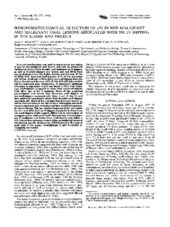| dc.contributor.author | Ibrahim, Salah Osman | en_US |
| dc.contributor.author | Johannessen, Anne Christine | en_US |
| dc.contributor.author | Idris, Ali M. | en_US |
| dc.contributor.author | Hirsch, Jan M. | en_US |
| dc.contributor.author | Vasstrand, Endre N. | en_US |
| dc.contributor.author | Magnusson, Bengt | en_US |
| dc.contributor.author | Nilsen, Rune | en_US |
| dc.date.accessioned | 2007-03-18T17:52:11Z | |
| dc.date.available | 2007-03-18T17:52:11Z | |
| dc.date.issued | 1996 | eng |
| dc.Published | International Journal of Cancer 68(6): 749-753 | |
| dc.identifier.issn | 0020-7136 | |
| dc.identifier.uri | https://hdl.handle.net/1956/2157 | |
| dc.description.abstract | Immunohistochemistry was used to examine the expression of p53 in pre-malignant oral lesions and oral squamous-cell carcinomas (SCCs) from Swedish and Sudanese snuff-dippers, as well as in pre-malignant oral lesions and oral SCCs from non-snuff-dippers from the Sudan, Sweden and Norway. Of the 14 SCCs from Sudanese snuff-dippers, 21% (3/14) expressed p53. Of the 14, 60 and 41 SCCs from non-snuff-dippers from the Sudan, Sweden and Norway, 64% (9/14), 65% (39/60) and 68% (28/41) expressed p53, respectively. A statistically significant difference in expression of p53 was found in SCCs from Sudanese snuff-dippers compared to those from non-snuff-dippers from all/or any of the 3 countries. None of the suspected pre-malignant oral lesions from Sudanese snuff dippers or non-snuff-dippers expressed p53. Only 2 out of the 15 oral fibro-epithelial hyperplastic lesions from Swedish snuff-dippers expressed p53. Some of the oral epithelial dysplastic lesions, as well as the carcinoma in situ lesions from Norwegian non-snuffdippers, expressed p53, while the oral fibro-epithelial hyperplastic lesions did not. The low relative frequency of p53 expression found in oral SCCs from snuff-dippers compared to those from non-snuff-dippers might suggest differences in mechanisms of oncogenic action induced by snuff. Alternatively, the pathogenesis of malignant oral lesions from snuff-dippers may follow a p53-independent pathway. In view of the unusually high levels of the tobacco-specific nitrosamines (TSNA) found in the type of snuff used in the Sudan, investigations of p53 mutations or oncogenes are needed. | en_US |
| dc.format.extent | 741197 bytes | eng |
| dc.format.mimetype | application/pdf | eng |
| dc.language.iso | eng | eng |
| dc.publisher | Wiley-Liss, Inc. | eng |
| dc.title | Immunohistochemical detection of p53 in non-malignant and malignant oral lesions associated with snuff dipping in the Sudan and Sweden | en_US |
| dc.type | Journal article | |
| dc.rights.holder | Copyright 1996 Wiley-Liss, Inc. | |
| dc.identifier.doi | https://doi.org/10.1002/(sici)1097-0215(19961211)68:6%3c749::aid-ijc10%3e3.0.co;2-w | |
| dc.subject.nsi | VDP::Medisinske Fag: 700 | nob |
| dc.subject.nsi | VDP::Medisinske Fag: 700::Helsefag: 800 | nob |
